1 Light Setup for Portraits (10 Best Lighting Patterns)
Light can make or break a portrait. But the good news is that you don’t need to buy a lot of fancy and expensive lighting equipment. You can create amazing portrait lighting patterns with one single light!
[highlight type= “short” price= “no” toc= “no” title= “Profit from Portraits” badge=” eBook” product= “30964”]Transform your photography passion into a profitable business with this eBook:
- Master a profitable photography niche to establish your brand.
- Learn to price your services for maximum profitability.
- Discover free methods to attract and retain long-term clients.
[/highlight]
What You Need for a 1 Light Setup for Portraits
Besides a camera, you need the following equipment:
- A speedlight (a strobe or video light works, too)
- A wireless flash trigger
- A tripod or light stand with a flash bracket to hold the light
- A diffuser to soften the light
- A reflector
It’s easy to spend a fortune on lighting gear. But the portrait lighting gear we used only cost a few hundred dollars (excluding the camera and lens). You can even spend less by buying used or budget-brand gear or using DIY lighting.
[short_roundup products=”38089,51649,98603,74453,35364,28996″ title=”Budget Gear for a 1 Light Setup for Portraits” tag=”eproundupshort-20″]
10 Best 1 Light Portrait Lighting Patterns
Here are ten one-light portrait lighting patterns for you to try.
1. Diffused On-Camera Flash
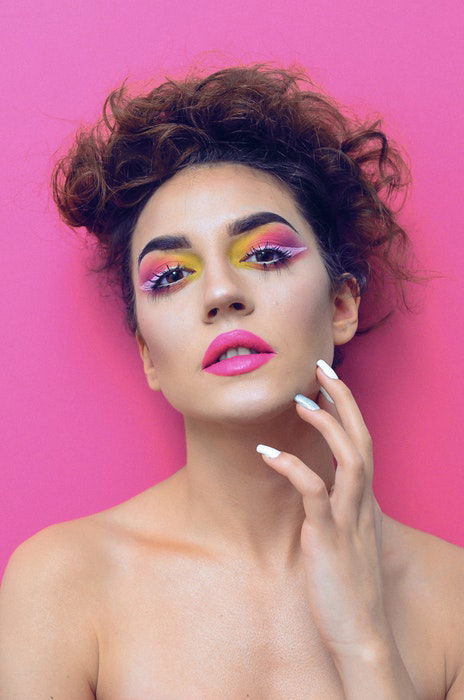
The Look
A simple diffused on-camera flash works as a fill light. It eliminates under-eye shadows and adds a sparkle to the eye.
The light comes from the same direction as the camera, meaning there are few shadows. If you soften the light, these can flatter imperfections like bumps and wrinkles in the skin.
This lighting pattern is the least interesting of the bunch. But when the lighting in the scene is already interesting, you can perfect the portrait with a slight fill using this technique.
The Setup
Leave the flash on your camera, but add a diffuser. Turn the flash to manual mode and dial it down. I often use this technique on the lowest possible flash setting.
When to Use It
If the sun already creates excellent lighting for portraits, a diffused on-camera flash can add one important detail—catchlights. Catchlight is the light source reflected in the subject’s eye. If you zoom into the model’s eye, you can spot the shape of the light source.
Catchlight adds dimension to the picture and draws the viewer’s attention to the eyes. Without the catchlight, the subject’s eye seems boring and lacks the sparkle that makes it look alive.
On-camera flash doesn’t add much dimension because the light comes from the same angle as the camera. Use it when the sunlight or a window is already adding that dimension.
If you only need a catchlight, there’s nothing wrong with popping in a little on-camera flash.
2. Bounced On-Camera Flash
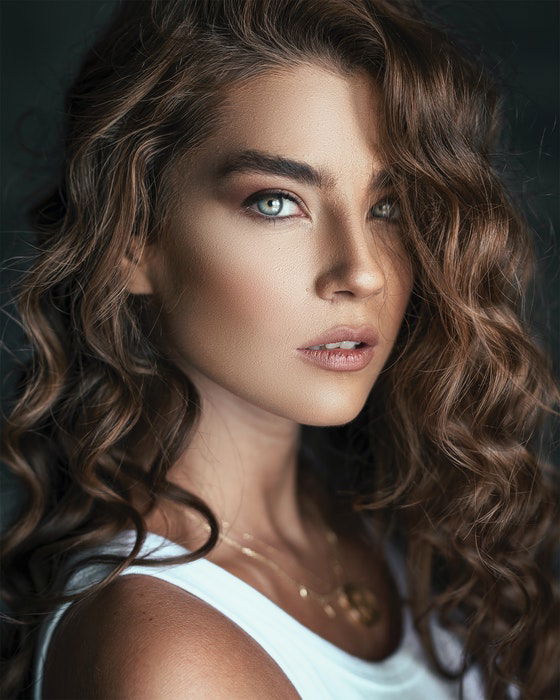
The Look
You get soft portrait light that hits the subject from an angle.
The Setup
Leave the flash on your camera. Place a reflector so it bounces the light back to your subject. Then, turn the flash head until it points into the reflector.
With this setup, you can adjust the reflector to get different looks. Try bouncing light into a reflector angled 45 degrees in front of the subject.
Or, point the flash head up and have someone angle the reflector over your head. This light creates a look similar to butterfly lighting with an off-camera flash. You don’t have to use a reflector, either. You can bounce your light off a neutral-colored wall or ceiling.
When to Use It
You might not have a radio transmitter to remove your flash from the camera. This method allows you to get soft, angled light in your portraits without one. The downside is that holding the reflector in the right position is difficult without help.
You can get a mount to hold the reflector on a tripod. But these are difficult to angle right and tend to tip over in the wind. Still, the light is flattering. And it’s an excellent stepping stone into off-camera lighting.
3. Butterfly Lighting
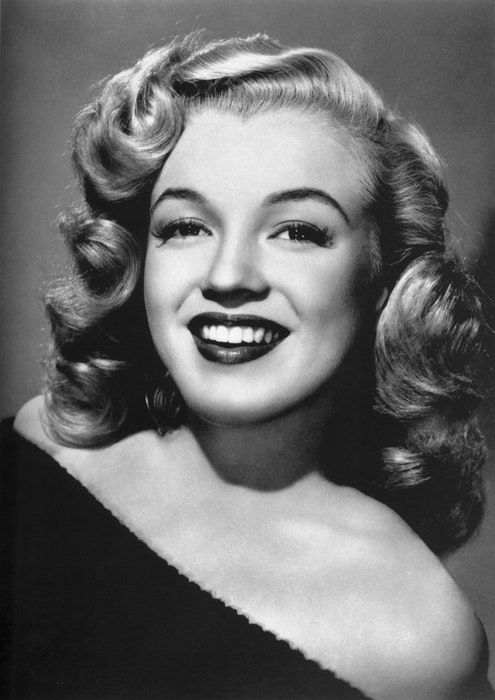
Notice the butterfly-shaped shadow below the nose
The Look
A soft light hits the subject from above, creating a small shadow underneath the nose and chin. These shadows help to make the subject’s face slimmer.
The shape of the shadow under the nose resembles a butterfly, hence the name. This lighting brightens up both eyes and both sides of the face equally.
The Setup
Place an off-camera light directly behind the camera. But, unlike an on-camera flash, raise the light stand so the light source is above the subject’s head. Then, angle the light toward the subject’s face at about 45 degrees.
When to Use It
Butterfly lighting is a popular but simple light technique for portraits. This setup can emphasize the jawline and the cheekbones. Try adjusting the modifiers from soft to hard. This setting allows for more variations from simple and flattering to dramatic.
The light is flattering to different skin types. It’s common for beauty photography and mimics a 1950s-style glamor shot. It’s also a flattering lighting setup for elderly subjects, as it doesn’t emphasize wrinkles much.
4. Clamshell Lighting
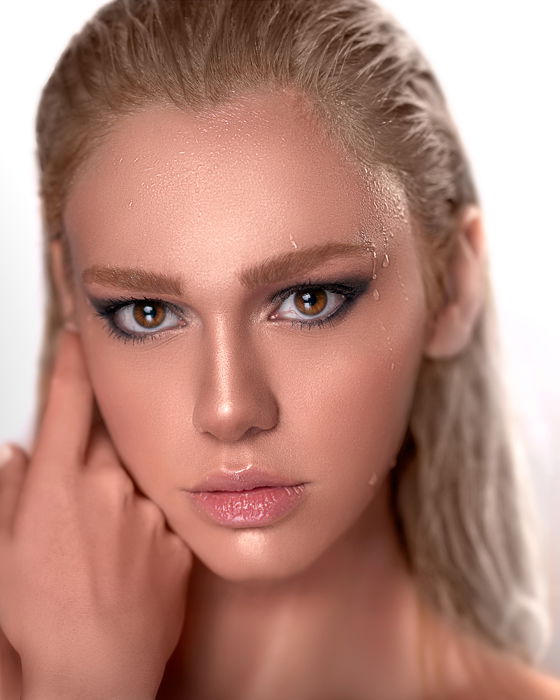
Photo by Amir Seilsepour
The Look
A clamshell lighting pattern uses light that hits the subject from above. But it fills in the shadows for an even softer light.
The look is characterized by two catchlights and a soft shadow below the chin. This lighting pattern also exaggerates the cheekbones and jawline.
The Setup
Set up a butterfly light with the flash above and behind the camera but angled down about 45 degrees. Add a reflector placed in the subject’s lap. Ask them to hold it in place. The reflector bounces some of that light back up as a fill light.
When to Use It
This soft, flattering light is common in beauty shots and portraits of women. The shadows on the cheekbones can slim the face and define the jawline.
While it’s a “beauty light,” that doesn’t mean you can’t use it with men. Portrait photographers using clamshell light on men tend to add harsher shadows by moving the light farther from the face.
5. Loop Lighting
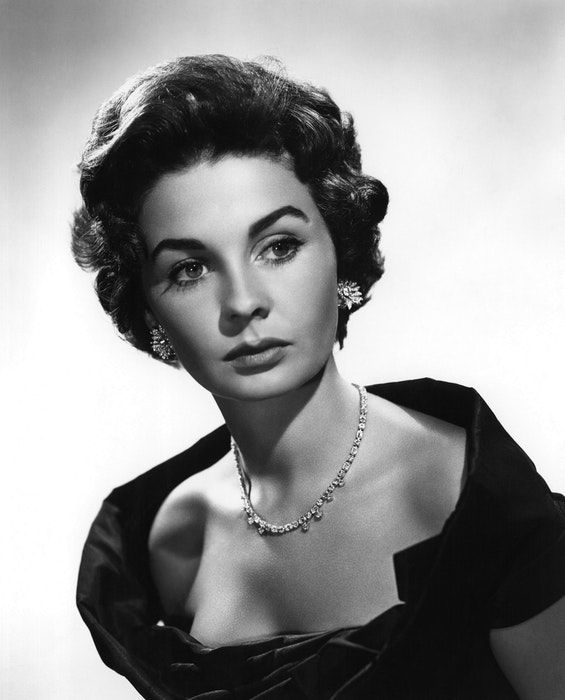
The Look
Most of the face is still well-lit, but you’re working with a key light off the camera’s side. This setup adds shadows to one side of the face. The light is easily identifiable by a short shadow on one corner of the nose. It’s not under, but not exactly to the side either.
The Setup
A loop light is a butterfly light but moved to one side of the subject. Place an off-camera light next to the camera and off to the side, up to a 45-degree angle from the subject.
The light should also be taller than the subject but angled down at them.
The light should be far from the camera to create shadows on one side of the face. But keep it close enough to the camera so both sides of the face are well-lit.
When to Use It
If you want the flattering light of a butterfly but with more interest and dimension, try loop lighting. This pattern is a happy medium between soft beauty lighting and dark and dramatic.
Bonus Variation
Use a reflector opposite of the light source to lighten the shadows.
6. One Light Rembrandt
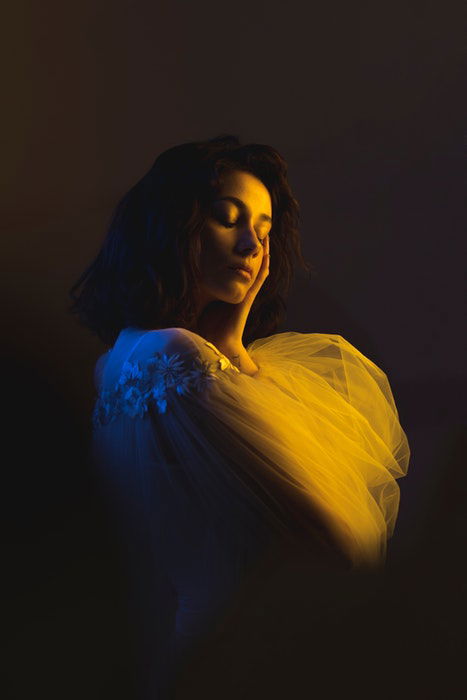
Photo by Yuliya Kosolapova (Pexels)
The Look
You can identify Rembrandt lighting by a triangle of light under one eye. The triangle-shaped light is on the cheek farthest from the light source.
The lighting setup got its name after the famous Dutch painter Rembrandt, whose paintings often showcase this kind of lighting. The Rembrandt lighting pattern also creates catchlights in both eyes.
The Setup
Move that loop lighting to a more extreme angle. Rembrandt lighting is typically a 45-degree angle.
But you need to move the light until the opposite side of the face only has a small triangle of light on the cheek just below the eye. The height of the light is a foot or two above eye level.
Rembrandt lighting is often a two-light setup. To achieve the style with a single light, use a reflector.
Like the main light, place the reflector at about a 45-degree angle from the subject but on the opposite side. Angle the reflector so that it bounces some of the main light back.
When to Use It
Rembrandt lighting is a traditional yet dramatic lighting style. This type of light is best for creating a more serious portrait, not a soft, smiling beauty shot. Photographers often use it when shooting male or masculine-looking models.
The more extreme side angle also makes skin textures less forgiving. Acne and wrinkles can be more noticeable in this style.
7. Rim Lighting
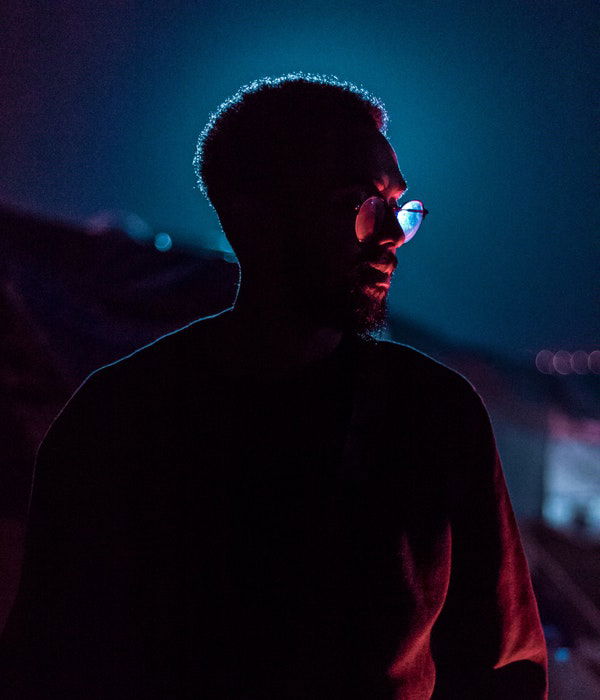
Photo by Abdulrhman Elkady (Pexels)
The Look
Rim lighting is more known for the highlights it creates than the shadows. This lighting pattern creates a narrow light rim on one side of the subject. Photographers often use rim lighting with a dark exposure to light the subject’s outline, but not always.
The Setup
Rim lighting also uses a light about 45 degrees from the subject. But the rim light is 45 degrees behind the subject.
Instead of placing the light next to the camera, place the light a few feet behind the subject and to the side. You can adjust the width and placement of that rim by changing the height.
If you want a dark image with only the subject’s outline, use manual exposure to get that dark look. If you want the subject’s face lit, expose it to the face and use a reflector towards the front of the subject.
When to Use It
Rim lighting is dramatic light that emphasizes the subject’s shape. It’s excellent for photographing athletes, exaggerating curves, or capturing a profile.
The rim of light can be unforgiving, making it less flattering for skin problems. It’s also difficult to light the subject’s face and rim outline without a fill light.
Bonus Tip
Add a colored gel for a more dramatic, fun rim light.
8. Split Lighting
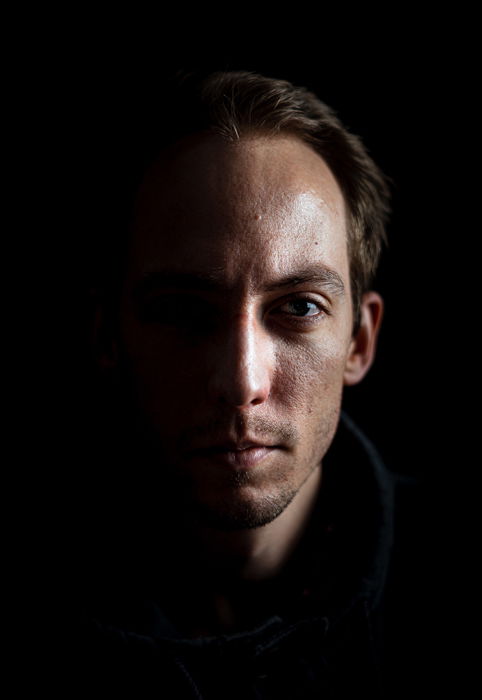
Photo by Peri Stojnic (Unsplash)
The Look
A light that splits the face exactly in half, with half the face well-lit and half the face in shadow. The second eye may or may not have a catch light.
The Setup
Place the light on the subject’s side, about face height. The light should only reach one side of the face, leaving the other dark. Since this lighting pattern is more dramatic, the light can be farther away, with or without a diffuser.
When to Use It
Split lighting is excellent for creating dramatic, moody images. The light is less forgiving of skin imperfections. A more dramatic look works better with a serious expression than a grin.
9. Split Lighting With a Reflector Fill
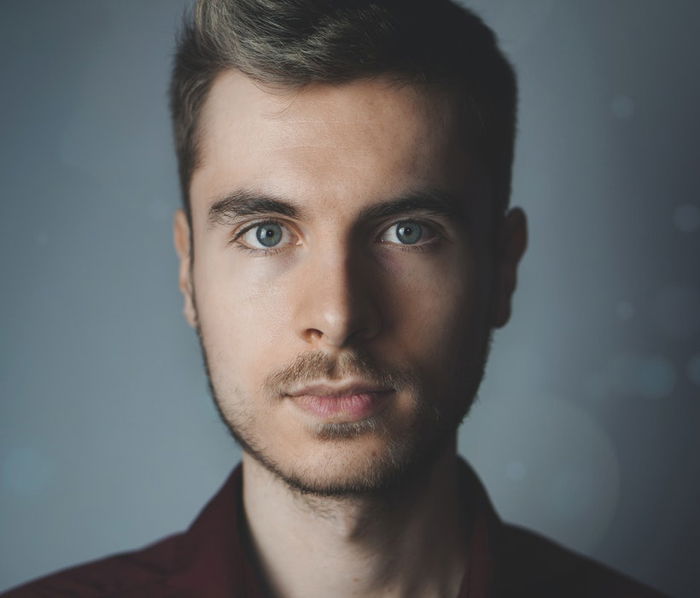
Photo by Simon Robben
The Look
Lighting that’s more prominent on one side than the other, but with both halves of the face visible.
The Setup
Like the typical split, place the key light directly to the subject’s side, about at face level. On the opposite side, use a reflector to direct some of that light back to the other side. A white reflector will create darker shadows than a silver reflector.
When to Use It
Use this setup if you love the drama of the split light but want to see the details on both sides of the subject’s face. The lighting is still dramatic, and one side is darker. But the reflector leaves more details intact.
10. Backlight With a Reflector Fill
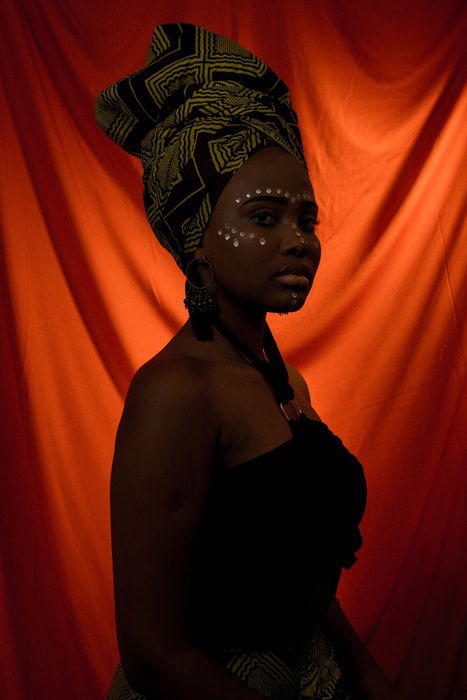
The Look
A halo-like light from behind the subject with soft light for the face.
The Setup
Place the light directly behind the subject. Lower the height of the light so that the camera can’t capture it. Leave the light tucked behind the head or the shoulders and point it a bit up.
Use a reflector at the front of the subject to bounce light back to the face. A shoot-through reflector is easier to hold for this look.
When to Use It
Backlighting gives your subject a sort of halo. And the reflector means that the light on the face is soft and flattering. This lighting pattern also separates the subject and background.
Avoid using it on a subject with lots of flyaway hair. This lighting can exaggerate the loose hair and create more retouching work.
What to Keep in Mind For One Light Portraits
So we’ve got ten portrait lighting patterns here. A few concepts apply to every (or almost every) setup.
One-light portrait lighting uses a single key or main light, often with a speedlight or strobe. It’s only one light. But you can supplement it with reflected light, window light, or sunlight.
Each lighting pattern discusses where to place the light concerning the subject. Remember that distance is also part of where you place the light. Closer light sources create a softer light. Moving the light farther from the subject spreads the light over a wider area.
Height is also important when placing the light source. These one-light portraits use a light at eye level with the subject or higher.
Lighting diffusers are also important for stunning portraits. They help smooth out the skin and expand the range of light reaching the subjects.
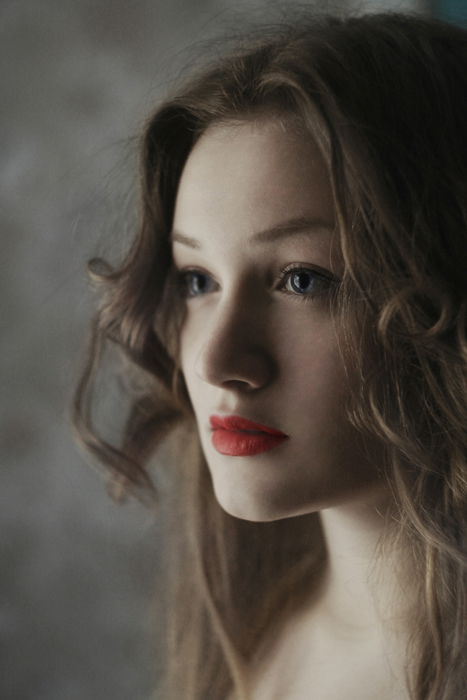
Photo by Roksolana Zasiadko
Note that face lighting from below is unnatural. It looks like holding a flashlight under your chin while sitting around a campfire to tell scary stories. It looks creepy.
There are always exceptions to the rules. But most portrait lighting techniques use an eye-level or higher light source. Eye-level tends to be both flattering and natural.
You can also add more variety by using a light modifier. Most portrait photographers use a diffuser for soft light. But an unmodified hard light can have its place, too.
A grid reduces the spread of the light. It also makes it so the light only falls on part of the image. And flash gels can change the color of the light in the shot.
Certain lighting patterns will work better on one subject than another. Lighting can emphasize the cheekbones, add catchlights to the eyes, and soften skin imperfections, to name a few. Keep this in mind as you decide which lighting pattern to use.
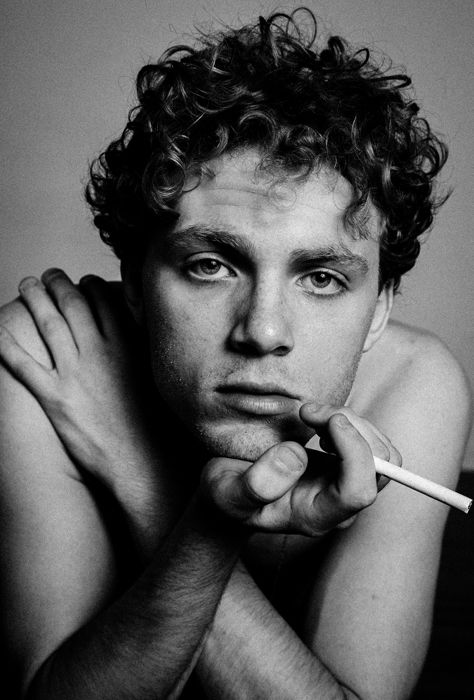
Photo by Taylor Hernandez on Unsplash
Conclusion: Best 1 Light Setup for Portraits
Lighting can create a more flattering portrait, add drama, and help the subject’s best features pop. But you don’t need lots of gear to create a variety of lighting effects. A one-light setup for portraits is all you need!
You can create different looks with a single speedlight, strobe, or video light. Add in a reflector, and those possibilities expand even further.
Take your portrait photography business to the next level with Profit from Portraits!
[highlight type= “short” price= “no” toc= “no” title= “Profit from Portraits” badge=” eBook” product= “30964”]Transform your photography passion into a profitable business with this eBook:
- Master a profitable photography niche to establish your brand.
- Learn to price your services for maximum profitability.
- Discover free methods to attract and retain long-term clients.
[/highlight]